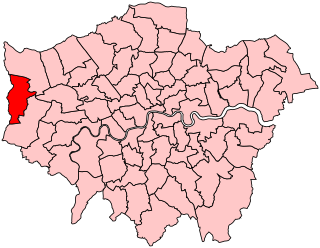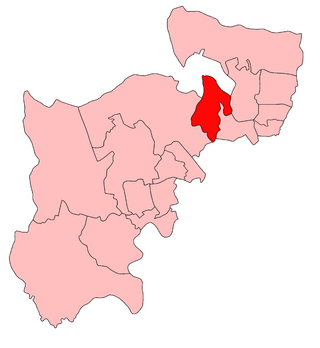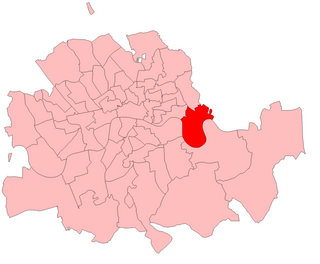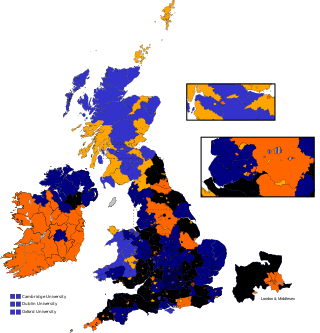
Bethnal Green and Bow is a constituency in Greater London, represented in the House of Commons of the UK Parliament from 2010 until its abolition for the 2024 general election by Rushanara Ali of the Labour Party.

Uxbridge was a seat returning one Member of Parliament (MP) of the House of Commons of the UK Parliament from 1885 to 2010. Its MPs elected were: Conservative Party candidates for 107 years and Labour Party candidates for 18 years. The closing 40 years of the seat's history saw Conservative victory — in 1997 on a very marginal majority in relative terms.

Finchley was a constituency represented in the House of Commons of the Parliament of the United Kingdom. It elected one Member of Parliament (MP) by first-past-the-post voting; its longest-serving and best-known MP was Margaret Thatcher, Prime Minister from 1979 to 1990. Although boundary changes meant that she never again attained the large majority by which she won in 1959, her constituents nonetheless returned her by comfortable (9,000) majorities at general elections throughout her premiership.

Balham and Tooting was a constituency in South London, which returned one Member of Parliament (MP) to the House of Commons of the Parliament of the United Kingdom. It was created for the 1918 general election and abolished for the 1950 general election.

Clapham was a borough constituency in South London which returned one Member of Parliament (MP) to the House of Commons of the UK Parliament. It was created in time for the 1885 general election then altered in periodic national boundary reviews, principally in 1918, and abolished before the February 1974 general election. In its early years the seat was officially named Battersea and Clapham Parliamentary Borough: No. 2—The Clapham Division.
Stepney was a parliamentary constituency centred on the Stepney district of the East End of London. It returned one Member of Parliament (MP) to the House of Commons of the Parliament of the United Kingdom, elected by the first past the post system.
Whitechapel and St George's was a parliamentary constituency in east London, which returned one Member of Parliament (MP) to the House of Commons of the Parliament of the United Kingdom.

Whitechapel was a parliamentary constituency in the Whitechapel district of East London. In 1885 the seat was established as a division of the parliamentary borough of Tower Hamlets. It returned one Member of Parliament (MP) to the House of Commons of the Parliament of the United Kingdom.

Brentford was a constituency named after the town of Brentford in Middlesex and was drawn to take in Hounslow, Norwood Green and Twickenham. It returned one Member of Parliament (MP) to the House of Commons of the UK Parliament. The constituency was created for the 1885 general election and abolished for that of 1918.
Brentford and Chiswick was a constituency 1918 – 1974 centred on the Brentford and Chiswick districts of Middlesex which became parts of west London in 1965. It returned one member (MP) to the House of Commons of the UK Parliament.
Wandsworth Central was a parliamentary constituency in the Wandsworth district of South London. It returned one Member of Parliament (MP) to the House of Commons of the Parliament of the United Kingdom, elected by the first-past-the-post voting system.

Mile End was a parliamentary constituency centred on the Mile End district of the East End of London. It returned one Member of Parliament (MP) to the House of Commons of the Parliament of the United Kingdom.

Poplar was a parliamentary constituency centred on the Poplar district of the East End of London. It returned one Member of Parliament (MP) to the House of Commons of the Parliament of the United Kingdom.

Bow and Bromley was a constituency in the Parliament of the United Kingdom. Located in the Metropolitan Borough of Poplar in London, it was created by the Redistribution of Seats Act for the 1885 general election and returned one Member of Parliament (MP) until it was abolished for the 1950 general election.
Finsbury Central was a parliamentary constituency that covered the Clerkenwell district of Central London. It returned one Member of Parliament (MP) to the House of Commons of the Parliament of the United Kingdom, elected by the first past the post system.
Finsbury East was a parliamentary constituency centred on the Finsbury district of North London, England. It returned one Member of Parliament (MP) to the House of Commons of the Parliament of the United Kingdom, elected by the first past the post system.
Hoxton was a borough constituency centred on the Hoxton district of London. It returned one Member of Parliament (MP) to the House of Commons of the Parliament of the United Kingdom, elected by the first past the post system.

Tower Hamlets was a parliamentary borough (constituency) in Middlesex, England from 1832 to 1885. It elected two Members of Parliament (MPs) to the House of Commons of the Parliament of the United Kingdom. It was one of the first five of its type in the metropolitan area of London. It was enfranchised by the Reform Act 1832.
Haggerston, formally known as the "Haggerston Division of Shoreditch", was a borough constituency centred on the Haggerston district of the Metropolitan Borough of Shoreditch in London. It returned one Member of Parliament (MP) to the House of Commons of the Parliament of the United Kingdom, elected by the first past the post system.
St George was a parliamentary constituency in what is now the London Borough of Tower Hamlets. It was part of the Parliamentary borough of Tower Hamlets and returned one Member of Parliament (MP) to the House of Commons of the Parliament of the United Kingdom.















